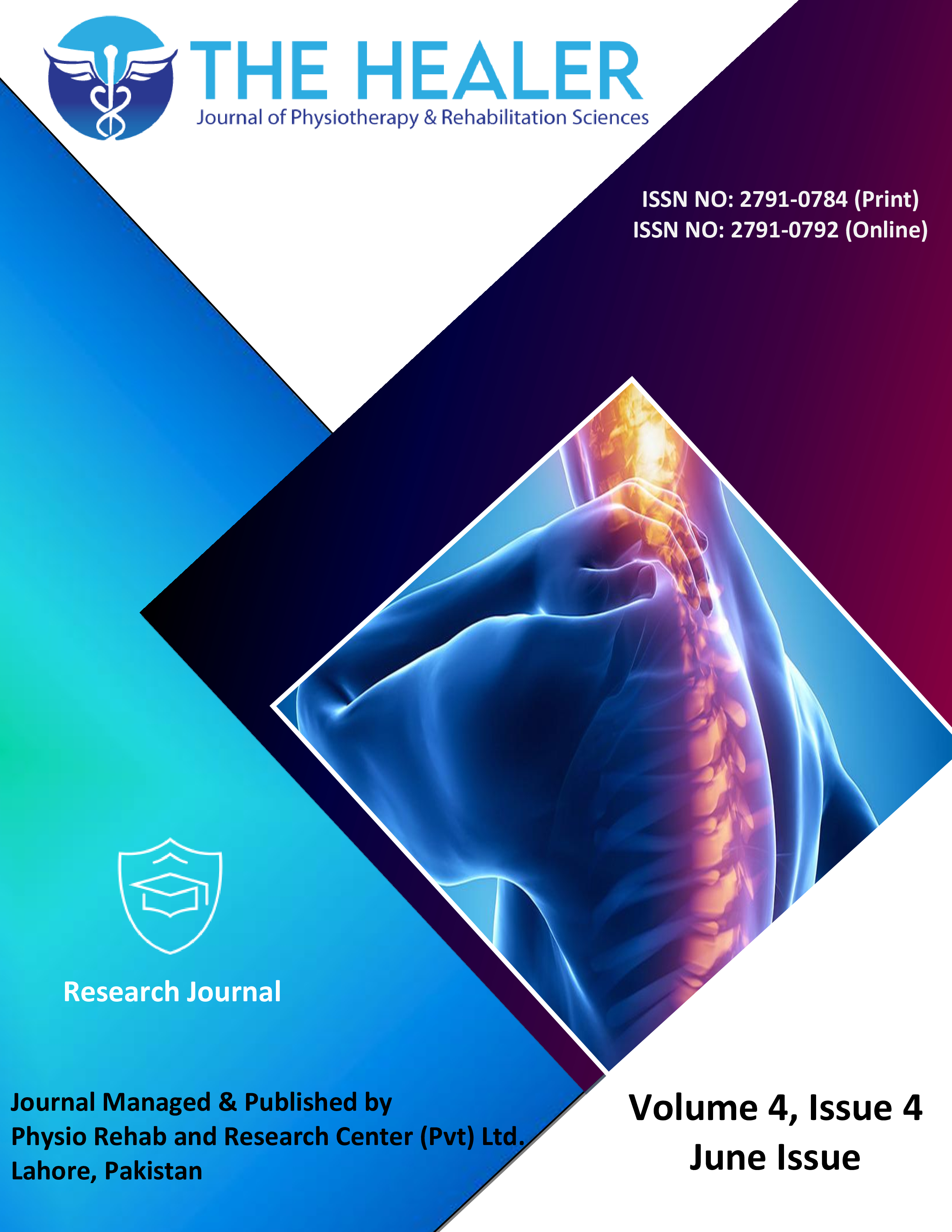Effects of Muscle Energy Techniques in addition to Routine Physical Therapy on Pain and Functional Disability in Post-Partum Females with Sacroiliac Joint Dysfunction
DOI:
https://doi.org/10.55735/tymtdt09Keywords:
Functional disability, Muscle energy technique, Post-partum , Sacroiliac joint dysfunctionAbstract
Background: Sacroiliac joint dysfunction is a common cause of low back pain, affecting 16 to 30% of patients with low back pain. Objective: To compare the effects of muscle energy techniques in addition to routine physical therapy on pain and functional disability in post-partum females with sacroiliac joint dysfunction. Methodology: A randomized controlled trial- using a non-probability purposive sampling technique, the sample size of 74 with 37 in each group, was selected and then divided into two groups. Group A received the muscle energy technique, and Group B received routine physical therapy. Modified Oswestry Disability scale and Numeric Pain Rating Scale were used to assess pain and functional disability in patients with sacroiliac joint dysfunction and data were collected at baseline, 0, and 4th week. The period was 9 months, and the age group was 20 to 40 years for females. Results: For both pain and MODI measures, there was a statistically significant difference in outcomes between the two groups. For pain week 4, the median was 3.00 for muscle energy and 4.00 for routine physical therapy, and the mean rank was 27.77 and 47.23, respectively, with a sum of ranks of 1027.50 and 1747.50. The Mann-Whitney U test showed a Z score of -3.965 and a P value of 0.000, indicating that muscle energy resulted in a significantly greater reduction in pain compared to routine physical therapy. For week 4 MODI, the median was 20.00 for technique A and 23.00 for technique B, and the mean rank was 28.62 and 46.38, respectively, with a sum of ranks of 1059.00 and 1716.00. The Mann-Whitney U test showed a Z score of -3.572 and a p-value of 0.000, indicating that technique A resulted in a significantly greater reduction in disability compared to technique B. Conclusion: The muscle energy technique was significantly more effective in reducing pain and disability compared to the routine physical therapy and technique B, respectively, in postpartum female patients with sacroiliac joint dysfunction. However, both groups showed statistically significant improvements in pain and disability at post-intervention compared to their respective baselines.
Downloads
References
1. Sachdeva S, Kalra S, Pawaria SJIJoHS, Care. Effects of Muscle Energy Technique versus Mobilization on Pain and Disability in Post-Partum Females with Sacroiliac Joint Dysfunction. 2018;5(1):11-7.
2. Raj MA, Varacallo M. Sacroiliac (SI) joint pain. 2017.
3. Fiani B, Sekhon M, Doan T, Bowers B, Covarrubias C, Barthelmass M, et al. Sacroiliac Joint and Pelvic Dysfunction Due to Symphysiolysis in Postpartum Women. 2021;13(10).
4. Kansagara PR, Patel JKJEE. Muscle Energy Technique for Sacroiliac Joint Dysfunction–An Evidence Based Practice. 2019;13(2):122.
5. Sharma D, Sen SJIJPR. Effects of muscle energy technique on pain and disability in subjects with SI joint dysfunction. 2014;2(1):305-11.
6. Hansen HC, Brown AM, Cohen SP, Swicegood JR, Colson JD, Manchikanti LJDoAoRoEQ-aR. Sacroiliac joint interventions: a systematic review. 2007.
7. Peebles R, Jonas CEJCSMR. Sacroiliac joint dysfunction in the athlete: diagnosis and management. 2017;16(5):336-42.
8. Nejati P, Safarcherati A, Karimi FJPP. Effectiveness of exercise therapy and manipulation on sacroiliac joint dysfunction: a randomized controlled trial. 2019;22(1):53-61.
9. Sarkar M, Goyal M, Samuel AJJASJ. Comparing the Effectiveness of the Muscle Energy Technique and Kinesio taping in Mechanical Sacroiliac Joint Dysfunction: A Non-blinded, Two-Group, Pretest–Posttest Randomized Clinical Trial Protocol. 2021;15(1):54.
10. Yavuz F, Kelle B, Balaban BJJoANR. The interventional pain management of sacroiliac joint pain: A brief review. 2015;2(2):25-9.
11. Selkow NM, Grindstaff TL, Cross KM, Pugh K, Hertel J, Saliba SJJom, et al. Short-term effect of muscle energy technique on pain in individuals with non-specific lumbopelvic pain: a pilot study. 2009;17(1):14E-8E.
12. Smith M, Fryer GJJob, therapies m. A comparison of two muscle energy techniques for increasing flexibility of the hamstring muscle group. 2008;12(4):312-7.
13. Brolinson PG, Kozar AJ, Cibor GJCSMR. Sacroiliac joint dysfunction in athletes. 2003;2(1):47-56.
14. Mathew R, Srivastava N, Joshi SJQFSTeoNESVIEiOoK. A study to compare the effectiveness of MET and joint mobilization along with conventional physiotherapy in the management of SI joint dysfunction in young adults. 2015;9(3):3203.
15. Kamali F, Shokri EJJob, therapies m. The effect of two manipulative therapy techniques and their outcome in patients with sacroiliac joint syndrome. 2012;16(1):29-35.
16. Santos Junior EJPdP-GeBdIdpeddUdVdP. Análise baropodométrica da influência da técnica manipulativa osteopática de correção sacroilíaca na distribuição da pressão plantar [Dissertação]. 2007.
17. Bindra SJHBR. A study on the efficacy of muscle energy technique as compared to conventional therapy on lumbar spine range of motion in chronic low back pain of sacroiliac origin. 2013;2(4):13.
18. Anderson DJC-KJ. Muscle energy technique for joint mobilisation. 2016;67:1-41.
19. Zelle BA, Gruen GS, Brown S, George SJTCjop. Sacroiliac joint dysfunction: evaluation and management. 2005;21(5):446-55.
20. Kumar J, Yadav J, Kalra SJIJoHS, Care. Effect of pelvic floor muscle exercises in comparison with core stability exercises on pain, functional status and abdominal muscle endurance in post-partum females with chronic low back pain. 2015;2(2):121-6.
21. Vaseghnia A, Shadmehr A, Moghadam BA, Olyaei G, Hadian MR, Khazaeipour Z. Effects of muscle energy technique on daily activities and lumbar stiffness in women with sacroiliac joint dysfunction: a randomized controlled clinical trial study. Journal of Modern Rehabilitation. 2019;13(1):23-30.
22. Lumley MA, Schubiner H. Emotional awareness and expression therapy for chronic pain: Rationale, principles and techniques, evidence, and critical review. Current Rheumatology Reports. 2019;21:1-8.
23. Wendt M, Cieślik K, Lewandowski J, Waszak M. Effectiveness of combined general rehabilitation gymnastics and muscle energy techniques in older women with chronic low back pain. BioMed Research International. 2019.
24. Wahyuddin W, Vongsirinavarat M, Mekhora K, Bovonsunthonchai S, Adisaipoapun R. Immediate effects of muscle energy technique and stabilization exercise in patients with chronic low back pain with suspected facet joint origin: A pilot study. Hong Kong Physiotherapy Journal. 2020;40(02):109-19.
25. Akram H, Bashir S, Zia A, Noor R, Shakeel A. Comparison of muscle energy technique and mobilization with movement to reduce pain and improve functional status in subjects with anterior innominate ilio-sacral dysfunction. Journal of Bodywork and Movement Therapies. 2022.
26. Chauhan P, Khare K, Vachchani K, Kapoor G. Effectiveness of muscle energy technique versus positional release therapy on range of motion and pain in non-specific low back pain. Indian Journal of Continuing Nursing Education. 2022;23(1):54.
27. Sbardella S, La Russa C, Bernetti A, Mangone M, Guarnera A, Pezzi L, et al., editors. Muscle energy technique in the rehabilitative treatment for acute and chronic non-specific neck pain: a systematic review. Healthcare; 2021: MDPI. 42. Ahmed UA, Maharaj SS, Van Oosterwijck J. Effects of dynamic stabilization exercises and muscle energy technique on selected biopsychosocial outcomes for patients with chronic non-specific low back pain: a double-blind randomized controlled trial. Scandinavian Journal of Pain. 2021;21(3):495-511.
28. Fatoye F, Gebrye T, Fatoye C, Mbada CE, Olaoye MI, Odole AC, et al. The clinical and cost-effectiveness of telerehabilitation for people with nonspecific chronic low back pain: randomized controlled trial. JMIR mHealth and uHealth. 2020;8(6):e15375.
29. Noreen A, Rashad A, Naeem F, Intikhab R, Angela C, Sonia A, et al. Comparative effect of graston technique and muscle energy technique on the flexibility of hamstring muscle. International Journal of Clinical Skills. 2022;16(8):255.
30. Patil S, Bhojwani M. Effect of Muscle Energy Technique as an Adjunct to Lumbar Stabilisation Exercise Training on Pain, Disability and Fear Avoidance belief in Patients with Chronic Low back pain with facet joint dysfunction: Randomized Controlled Trial. Indian Journal of Forensic Medicine & Toxicology. 2022;16(3):349-53 46. Kansagara P, Patel J. Muscle energy technique for sacroiliac joint dysfunction: an evidence-based practice. Executive Editor. 2019;13(2):122-26.

Downloads
Published
License
Copyright (c) 2024 The Healer Journal of Physiotherapy and Rehabilitation Sciences

This work is licensed under a Creative Commons Attribution 4.0 International License.














